LRT Line 2 (Metro Manila)
The Light Rail Transit Line 2, also known as LRT Line 2 (LRT-2), and previously MRT Line 2 (MRT-2) or Megatren, is a rapid transit line in Metro Manila in the Philippines, generally running in an east–west direction along the Radial Road 6 and a portion of the Circumferential Road 1.
| LRT Line 2 | |||||||||||||||||||||||||||||||||||||||||||||||||||||||||||||||||||||||||||||||||||||||||||||||||||||||||||||||||||||||||||||||||||||||||||||||||||||||||||||||||||||||||||||||||||||||||||||||||||||||||||||||||||||||||||||||||||||||||||||||||||||||||||||||||||||||||||||
|---|---|---|---|---|---|---|---|---|---|---|---|---|---|---|---|---|---|---|---|---|---|---|---|---|---|---|---|---|---|---|---|---|---|---|---|---|---|---|---|---|---|---|---|---|---|---|---|---|---|---|---|---|---|---|---|---|---|---|---|---|---|---|---|---|---|---|---|---|---|---|---|---|---|---|---|---|---|---|---|---|---|---|---|---|---|---|---|---|---|---|---|---|---|---|---|---|---|---|---|---|---|---|---|---|---|---|---|---|---|---|---|---|---|---|---|---|---|---|---|---|---|---|---|---|---|---|---|---|---|---|---|---|---|---|---|---|---|---|---|---|---|---|---|---|---|---|---|---|---|---|---|---|---|---|---|---|---|---|---|---|---|---|---|---|---|---|---|---|---|---|---|---|---|---|---|---|---|---|---|---|---|---|---|---|---|---|---|---|---|---|---|---|---|---|---|---|---|---|---|---|---|---|---|---|---|---|---|---|---|---|---|---|---|---|---|---|---|---|---|---|---|---|---|---|---|---|---|---|---|---|---|---|---|---|---|---|---|---|---|---|---|---|---|---|---|---|---|---|---|---|---|---|---|---|---|---|---|---|---|---|---|---|---|---|---|---|---|---|---|
 | |||||||||||||||||||||||||||||||||||||||||||||||||||||||||||||||||||||||||||||||||||||||||||||||||||||||||||||||||||||||||||||||||||||||||||||||||||||||||||||||||||||||||||||||||||||||||||||||||||||||||||||||||||||||||||||||||||||||||||||||||||||||||||||||||||||||||||||
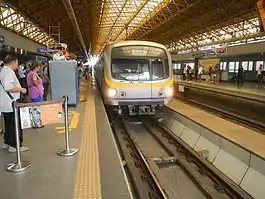 A LRTA 2000 class train approaching Araneta Center–Cubao station | |||||||||||||||||||||||||||||||||||||||||||||||||||||||||||||||||||||||||||||||||||||||||||||||||||||||||||||||||||||||||||||||||||||||||||||||||||||||||||||||||||||||||||||||||||||||||||||||||||||||||||||||||||||||||||||||||||||||||||||||||||||||||||||||||||||||||||||
| Overview | |||||||||||||||||||||||||||||||||||||||||||||||||||||||||||||||||||||||||||||||||||||||||||||||||||||||||||||||||||||||||||||||||||||||||||||||||||||||||||||||||||||||||||||||||||||||||||||||||||||||||||||||||||||||||||||||||||||||||||||||||||||||||||||||||||||||||||||
| Status | Operational | ||||||||||||||||||||||||||||||||||||||||||||||||||||||||||||||||||||||||||||||||||||||||||||||||||||||||||||||||||||||||||||||||||||||||||||||||||||||||||||||||||||||||||||||||||||||||||||||||||||||||||||||||||||||||||||||||||||||||||||||||||||||||||||||||||||||||||||
| Owner | Department of Transportation – Light Rail Transit Authority | ||||||||||||||||||||||||||||||||||||||||||||||||||||||||||||||||||||||||||||||||||||||||||||||||||||||||||||||||||||||||||||||||||||||||||||||||||||||||||||||||||||||||||||||||||||||||||||||||||||||||||||||||||||||||||||||||||||||||||||||||||||||||||||||||||||||||||||
| Line number | 2 | ||||||||||||||||||||||||||||||||||||||||||||||||||||||||||||||||||||||||||||||||||||||||||||||||||||||||||||||||||||||||||||||||||||||||||||||||||||||||||||||||||||||||||||||||||||||||||||||||||||||||||||||||||||||||||||||||||||||||||||||||||||||||||||||||||||||||||||
| Locale | Metro Manila, Philippines | ||||||||||||||||||||||||||||||||||||||||||||||||||||||||||||||||||||||||||||||||||||||||||||||||||||||||||||||||||||||||||||||||||||||||||||||||||||||||||||||||||||||||||||||||||||||||||||||||||||||||||||||||||||||||||||||||||||||||||||||||||||||||||||||||||||||||||||
| Termini | Santolan Recto | ||||||||||||||||||||||||||||||||||||||||||||||||||||||||||||||||||||||||||||||||||||||||||||||||||||||||||||||||||||||||||||||||||||||||||||||||||||||||||||||||||||||||||||||||||||||||||||||||||||||||||||||||||||||||||||||||||||||||||||||||||||||||||||||||||||||||||||
| Stations | 11[1] | ||||||||||||||||||||||||||||||||||||||||||||||||||||||||||||||||||||||||||||||||||||||||||||||||||||||||||||||||||||||||||||||||||||||||||||||||||||||||||||||||||||||||||||||||||||||||||||||||||||||||||||||||||||||||||||||||||||||||||||||||||||||||||||||||||||||||||||
| Website | Official website | ||||||||||||||||||||||||||||||||||||||||||||||||||||||||||||||||||||||||||||||||||||||||||||||||||||||||||||||||||||||||||||||||||||||||||||||||||||||||||||||||||||||||||||||||||||||||||||||||||||||||||||||||||||||||||||||||||||||||||||||||||||||||||||||||||||||||||||
| Service | |||||||||||||||||||||||||||||||||||||||||||||||||||||||||||||||||||||||||||||||||||||||||||||||||||||||||||||||||||||||||||||||||||||||||||||||||||||||||||||||||||||||||||||||||||||||||||||||||||||||||||||||||||||||||||||||||||||||||||||||||||||||||||||||||||||||||||||
| Type | Rapid transit / Heavy rail | ||||||||||||||||||||||||||||||||||||||||||||||||||||||||||||||||||||||||||||||||||||||||||||||||||||||||||||||||||||||||||||||||||||||||||||||||||||||||||||||||||||||||||||||||||||||||||||||||||||||||||||||||||||||||||||||||||||||||||||||||||||||||||||||||||||||||||||
| System | Manila Light Rail Transit System | ||||||||||||||||||||||||||||||||||||||||||||||||||||||||||||||||||||||||||||||||||||||||||||||||||||||||||||||||||||||||||||||||||||||||||||||||||||||||||||||||||||||||||||||||||||||||||||||||||||||||||||||||||||||||||||||||||||||||||||||||||||||||||||||||||||||||||||
| Services | 1[1] | ||||||||||||||||||||||||||||||||||||||||||||||||||||||||||||||||||||||||||||||||||||||||||||||||||||||||||||||||||||||||||||||||||||||||||||||||||||||||||||||||||||||||||||||||||||||||||||||||||||||||||||||||||||||||||||||||||||||||||||||||||||||||||||||||||||||||||||
| Operator(s) | Light Rail Transit Authority | ||||||||||||||||||||||||||||||||||||||||||||||||||||||||||||||||||||||||||||||||||||||||||||||||||||||||||||||||||||||||||||||||||||||||||||||||||||||||||||||||||||||||||||||||||||||||||||||||||||||||||||||||||||||||||||||||||||||||||||||||||||||||||||||||||||||||||||
| Depot(s) | Santolan | ||||||||||||||||||||||||||||||||||||||||||||||||||||||||||||||||||||||||||||||||||||||||||||||||||||||||||||||||||||||||||||||||||||||||||||||||||||||||||||||||||||||||||||||||||||||||||||||||||||||||||||||||||||||||||||||||||||||||||||||||||||||||||||||||||||||||||||
| Rolling stock | Class 2000 EMUs[1] | ||||||||||||||||||||||||||||||||||||||||||||||||||||||||||||||||||||||||||||||||||||||||||||||||||||||||||||||||||||||||||||||||||||||||||||||||||||||||||||||||||||||||||||||||||||||||||||||||||||||||||||||||||||||||||||||||||||||||||||||||||||||||||||||||||||||||||||
| Daily ridership | 179,967 (2018 average)[2] 241,125 (2018 record)[2] | ||||||||||||||||||||||||||||||||||||||||||||||||||||||||||||||||||||||||||||||||||||||||||||||||||||||||||||||||||||||||||||||||||||||||||||||||||||||||||||||||||||||||||||||||||||||||||||||||||||||||||||||||||||||||||||||||||||||||||||||||||||||||||||||||||||||||||||
| History | |||||||||||||||||||||||||||||||||||||||||||||||||||||||||||||||||||||||||||||||||||||||||||||||||||||||||||||||||||||||||||||||||||||||||||||||||||||||||||||||||||||||||||||||||||||||||||||||||||||||||||||||||||||||||||||||||||||||||||||||||||||||||||||||||||||||||||||
| Opened | April 5, 2003[1] | ||||||||||||||||||||||||||||||||||||||||||||||||||||||||||||||||||||||||||||||||||||||||||||||||||||||||||||||||||||||||||||||||||||||||||||||||||||||||||||||||||||||||||||||||||||||||||||||||||||||||||||||||||||||||||||||||||||||||||||||||||||||||||||||||||||||||||||
| Technical | |||||||||||||||||||||||||||||||||||||||||||||||||||||||||||||||||||||||||||||||||||||||||||||||||||||||||||||||||||||||||||||||||||||||||||||||||||||||||||||||||||||||||||||||||||||||||||||||||||||||||||||||||||||||||||||||||||||||||||||||||||||||||||||||||||||||||||||
| Track length | 13.8 km (8.6 mi) | ||||||||||||||||||||||||||||||||||||||||||||||||||||||||||||||||||||||||||||||||||||||||||||||||||||||||||||||||||||||||||||||||||||||||||||||||||||||||||||||||||||||||||||||||||||||||||||||||||||||||||||||||||||||||||||||||||||||||||||||||||||||||||||||||||||||||||||
| Character | Mostly Elevated with some Underground sections | ||||||||||||||||||||||||||||||||||||||||||||||||||||||||||||||||||||||||||||||||||||||||||||||||||||||||||||||||||||||||||||||||||||||||||||||||||||||||||||||||||||||||||||||||||||||||||||||||||||||||||||||||||||||||||||||||||||||||||||||||||||||||||||||||||||||||||||
| Track gauge | 1,435 mm (4 ft 8 1⁄2 in) standard gauge | ||||||||||||||||||||||||||||||||||||||||||||||||||||||||||||||||||||||||||||||||||||||||||||||||||||||||||||||||||||||||||||||||||||||||||||||||||||||||||||||||||||||||||||||||||||||||||||||||||||||||||||||||||||||||||||||||||||||||||||||||||||||||||||||||||||||||||||
| Electrification | 1,500 V DC overhead line | ||||||||||||||||||||||||||||||||||||||||||||||||||||||||||||||||||||||||||||||||||||||||||||||||||||||||||||||||||||||||||||||||||||||||||||||||||||||||||||||||||||||||||||||||||||||||||||||||||||||||||||||||||||||||||||||||||||||||||||||||||||||||||||||||||||||||||||
| Operating speed | 30–60 km/h (19–37 mph) | ||||||||||||||||||||||||||||||||||||||||||||||||||||||||||||||||||||||||||||||||||||||||||||||||||||||||||||||||||||||||||||||||||||||||||||||||||||||||||||||||||||||||||||||||||||||||||||||||||||||||||||||||||||||||||||||||||||||||||||||||||||||||||||||||||||||||||||
| |||||||||||||||||||||||||||||||||||||||||||||||||||||||||||||||||||||||||||||||||||||||||||||||||||||||||||||||||||||||||||||||||||||||||||||||||||||||||||||||||||||||||||||||||||||||||||||||||||||||||||||||||||||||||||||||||||||||||||||||||||||||||||||||||||||||||||||
Although the line is operated by the Light Rail Transit Authority, resulting in it being called as "LRT-2", it is actually a heavy rail, rapid transit system owing to its use of electric multiple units instead of the light rail vehicles used in earlier lines and is presently the only line utilizing such vehicles in the country until the opening of MRT Line 7 (MRT-7) in 2021 or 2022 and the Metro Manila Subway (MMS) in 2025.
Envisioned in the 1970s as part of the Metropolitan Manila Strategic Mass Rail Transit Development Plan, the eleven-station, 16.75-kilometer (10.41 mi) line was the third rapid transit line to be built in Metro Manila when it started operations in 2003. It is operated by the Light Rail Transit Authority (LRTA), a government-owned and controlled corporation attached to the Department of Transportation (DOTr) under an official development assistance scheme.
Serving close to 200,000 passengers daily, the line is the least busy among Metro Manila's three rapid transit lines, and was built with standards such as barrier-free access and the use of magnetic card tickets to facilitate passenger access in mind. Total ridership however is significantly below the line's built maximum capacity, with various solutions being proposed or implemented to increase ridership in addition to the planned extensions to the line. However, the short-term solutions have had a minimal effect on ridership, and experts have insisted that the extensions be built immediately, despite pronouncements that the system is steadily increasing ridership each year. Regardless, the line encounters periods of peak ridership during rush hour in the morning and the evening.
The line is integrated with the public transit system in Metro Manila, and passengers also take various forms of road-based public transport, such as buses and jeepneys, to and from a station to reach their intended destination. Although the line aimed to reduce traffic congestion and travel times along R-6 and portions of C-1, the transportation system has only been partially successful due to the rising number of motor vehicles and rapid urbanization. Expanding the network's revenue line to accommodate more passengers is set on tackling this problem.
Route

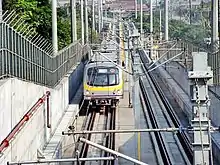
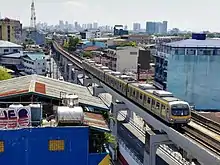
The line serves 11 stations on 13.8 kilometers (8.6 mi) of line.[1] The rails are mostly elevated and erected either over or along the roads covered, with sections below ground before and after the Katipunan station, the only underground station on the line. The western terminus of the line is the Recto station at Recto Avenue, while the eastern terminus of the line is the Santolan station along Marcos Highway.
The rail line serves the cities that Radial Road 6 (Marcos Highway, Aurora Boulevard, Ramon Magsaysay Boulevard, Legarda Street and Recto Avenue) passes through: Manila, San Juan, Quezon City, Marikina City and Pasig City (depot).
Three stations serve as interchanges between the lines operated by the Light Rail Manila Corporation (LRMC), Metro Rail Transit Corporation (MRTC), and Philippine National Railways (PNR). Pureza station is indirectly connected to the PNR Santa Mesa station; Araneta Center-Cubao indirectly connects with the MRT Line 3 station of the same name through local streets inside Araneta City (or formerly, Araneta Center); and Recto station is indirectly connected to the LRT Line 1 Doroteo Jose station through a covered walkway.
Starting in October 2019, three stations from Santolan to Anonas segment were temporarily closed due to a fire that affected two rectifier substations of the aforementioned section, leaving only 8 stations on the Araneta Center–Cubao to Recto segment and 5 train sets in operation. The estimated time of repair and reopening of the stations will last from 6 to 9 months.[3] The repairs for the affected sections of the train line were delayed many times amidst the COVID-19 pandemic, affecting the procurement of the necessary equipment, and due to the limited workforce in repairs after following strict safety restrictions. In September 2020, the LRTA Board has approved a Notice to Proceed for the reparations project in the affected areas, and the segment was reopened on January 22, 2021.[4]
| Name | Distance (km) | Rail/Bus Transfers | Location | |
|---|---|---|---|---|
| Between stations | From Santolan | |||
| Masinag | — | — | Bus 9 | Antipolo City, Rizal |
| Emerald | — | — | Bus 9 | Marikina City |
| Santolan | — | 0.000 | BFCT East Metro Manila Transport Terminal, Bus 9 |
Marikina City / Pasig City (depot) |
| Katipunan | 1.970 | 1.970 | Bus 8, 9 | Quezon City |
| Anonas | 0.955 | 2.925 | MMS Metro Manila Subway, Bus 8, 9 | |
| Araneta Center–Cubao | 1.438 | 4.363 | 3 MRT Line 3, EDSA Busway, Bus 8, 9, 10 | |
| Betty Go-Belmonte | 1.164 | 5.527 | Bus 10 | |
| Gilmore | 1.075 | 6.602 | Bus 10, 11 | |
| J. Ruiz | 0.928 | 7.530 | Bus 10 | San Juan City |
| V. Mapa | 1.234 | 8.764 | Bus 10 | Manila |
| Pureza | 1.357 | 10.121 | via Santa Mesa, Bus 10 | |
| Legarda | 1.389 | 11.510 | Bus 10 | |
| Recto | 1.050 | 12.560 | via Doroteo Jose, Bus 10 | |
| Tutuban | — | — | NSCR North–South Commuter Railway | |
| Divisoria | — | — | none | |
| Pier 4 | — | — | North Port Passenger Terminal, Bus 2 | |
| Stations and train systems in italics are under construction. | ||||
The line runs from 5:00 a.m. PST (UTC+8) until 10:00 p.m on weekdays, and 5:00 a.m. PST (UTC+8) until 9:30 pm during weekends and holidays. It operates almost every day of the year unless otherwise announced. Special schedules are announced via the PA system at every station and also in newspapers and other mass media. During Holy Week, a public holiday in the Philippines, the rail system is closed for annual maintenance, owing to fewer commuters and traffic around the metro. Normal operation resumes on Monday.[5]
History
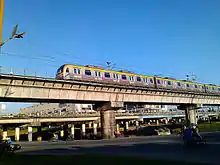
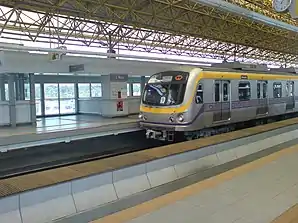
(2017-09-22).jpg.webp)
During the construction of the first line of the Manila Light Rail Transit System in the early 1980s, Electrowatt Engineering Services of Zürich designed a comprehensive plan for metro service in Metro Manila. The plan—still used as the basis for planning new metro lines—consisted of a 150-kilometer (93 mi) network of rapid transit lines spanning all major corridors within 20 years, including a line on the Radial Road 6 alignment, one of the region's busiest road corridor.
The Line 2 project officially began in 1996, twelve years after the opening of Line 1, with the granting of the soft loans for the line's construction. However, construction barely commenced, with the project stalled as the Philippine government conducted several investigations into alleged irregularities with the project's contract. The consortium of local and foreign companies, led by Marubeni Corporation, formed the Asia-Europe MRT Consortium (AEMC) which won the contract and restarted the project in 2000 after getting cleared from the allegations.
The AEMC was subsequently given the approval to commence construction by the DOTC and LRTA. The LRTA would have ownership of the system and assume all administrative functions, such as the regulation of fares and operations as well as the responsibility over construction and maintenance of the system and the procurement of spare parts for trains.
Construction started in March 1996 after the LRTA signed the first three packages of the agreement with Sumitomo Corporation delivering Package 1 in which covers the construction of the depot and its facilities, while the Hanjin-Itochu Joint Venture delivered packages 2 and 3 in which covers the substructure and the superstructure plus the stations respectively. The final package which was the package 4 agreement was signed after several delays with Asia-Europe MRT Consortium which was composed of Marubeni Corporation, Balfour Beatty, Toshiba, Daewoo Heavy Industries, and a local company which was D.M. Consuji Incorporated (DMCI) in which includes the communications and fares systems, vehicles, and trackworks.
During construction, the LRTA oversaw all the design, construction, equipping, testing, commissioning, and technical supervision of the project activities.
On April 5, 2003, the initial section, from Santolan to Araneta Center-Cubao was inaugurated by President Gloria Macapagal-Arroyo, with all remaining stations opening on April 5, 2004 except for Recto which opened on October 29, 2004. However, ridership was initially moderate yet still far below expectations, since the passenger volume in this line is not yet fully achieved.
To address passenger complaints on earlier train lines, the LRTA made sure during the construction phase that the stations are PWD (Person(s) with disability) friendly by putting up escalators and elevators for easier access, as well as making passenger fares at par with the other existing lines.
Station facilities, amenities, and services



With the exception of Katipunan station, all stations are above ground.
Station layout and accessibility
Stations have a standard layout, with a concourse level and a platform level. The concourse is usually below the platform except for the underground station, with stairs, escalators and elevators leading down to the platform level. The levels are separated by fare gates.
The concourse contains ticket booths. Some stations, such as Araneta Center-Cubao, are connected at concourse level to nearby buildings, such as shopping malls, for easier accessibility.
Stations either have island platforms, such as Santolan, or side platforms, such as Gilmore and Recto. Part of the platform at the front of the train is cordoned off for the use of pregnant women, children, elderly, and persons with disabilities. At side-platform stations, passengers need to enter the concourse area to enter the other platforms, while passengers can easily switch sides at stations with island platforms. Stations have toilets at the concourse level.
All stations are barrier-free inside and outside the station, and trains have spaces for passengers using wheelchairs.
Shops and services
Inside the concourse of all stations is at least one stall or stand where people can buy food or drinks. Stalls vary by station, and some have fast food stalls. The number of stalls also varies by station, and stations tend to have a wide variety, especially in stations such as Recto and V. Mapa.
Stations such as Recto and Santolan are connected to or are near shopping malls and/or other large shopping areas, where commuters are offered more shopping varieties.
In cooperation with the Philippine Daily Inquirer, passengers are offered a copy of the Inquirer Libre, a free, tabloid-size, Tagalog version of the Inquirer, which is available from 6 a.m. at all stations.
Safety and security
The line has always presented itself as a safe system to travel in, which was affirmed in a 2004 World Bank paper prepared by Halcrow describing the overall state of metro rail transit operations in Manila as being "good".[6]
With an estimated daily ridership of 200,000 passengers, the line operates significantly below its designed capacity of between 570,000 and 580,000 passengers per day. Operating under capacity since 2004,[7] government officials have admitted that system extensions are overdue, although in the absence of major investment in the system's expansion, LRTA has resorted to experimenting with and/or implementing other solutions to maximize the use of the system, including having bus feeder lines.[8]
For safety and security reasons, persons who are visibly intoxicated, insane and/or under the influence of controlled substances, persons carrying flammable materials and/or explosives, persons carrying bulky objects or items over 1.5 meters (4 ft 11 in) tall and/or wide, and persons bringing pets and/or other animals are prohibited from entering the line. Products in tin cans are also prohibited, citing the possibility of home-made bombs being concealed inside the cans.[9]
In response to the Rizal Day bombings and the September 11 attacks, security has been stepped up on board. The Philippine National Police has a special police force,[10] and security police provided by private companies can be found in all stations. All stations have a head guard. Some stations may also have a deployed K9 bomb-sniffing dog. The line also employs the use of closed-circuit television inside all stations to monitor suspicious activities and to assure safety and security aboard the line. Passengers are also advised to look out for thieves, who can take advantage of the crowding aboard the trains. Wanted posters are posted at all stations to help commuters identify known thieves.
Fares and ticketing
The line, like all existing lines in Metro Manila, uses a distance-based fare structure, with fares ranging from fifteen to twenty five pesos (34 to 56 U.S. cents), depending on the destination. Commuters who ride the line are charged ₱15 for the first three stations, ₱20 for 4–7 stations and ₱25 for 8–10 stations or the entire line. Children below 1.02 meters (3 ft 4 in) (the height of a fare gate) may ride for free.
Types of tickets
Four types of tickets exist: a single-journey (one-way) ticket whose cost is dependent on the destination, a stored-value (multiple-use) ticket for 100 pesos, a discounted stored value ticket (multiple-use) which can only be availed by senior citizens and disabled persons, and a single journey ticket for employees (one-way) which is exclusive for LRTA employees only. The single-journey ticket and the single journey ticket for employees is valid only on the date of purchase. Meanwhile, the stored-value ticket and the discounted stored-value ticket is valid for four years from date of purchase.
Tickets come in four incarnations: one bearing the portrait of Gloria Macapagal-Arroyo, which have since been phased out, although some tickets have been recycled due to ticket shortages, one with the Line 1 third generation train inauguration together with Japanese Prime Minister Shinzo Abe, one with the LRT-MRT closing the loop project design with Gloria Macapagal-Arroyo again in the picture, and one with a picture of the Hyundai Rotem EMUs used in the line which featured different designs for the single journey and stored value tickets with the former having a picture of the train unloading, while the latter is a flipped concept art of the train.
In the past, Line 3 borrowed tickets from LRTA rather than recycling the old "Erap tickets", due to the same ticket shortages.[11]
Despite the common practice for regular passengers to purchase several stored-value tickets at a time, the line barely has ticket shortages due to the inter-compatibility of tickets with the LRTA lines and the steady release of new tickets that addresses the problem.
Although the LRTA, together with Line 3 has experimented with the Flash Pass as an alternative ticketing system in the past, this was phased out in 2009.
On July 20, 2015, a new ticketing system called Beep was introduced. The Beep is a new contactless smart card to replace the old Magnetic Cards, starting on the Legarda Station as a trial station. And targeted to be used on all train system by September 2015. The new Beep has two types of card: the Single Journey Ticket (SJT) and the Stored Value Ticket (SVT) where the SVT will last for 4 years rather than the old Magnetic card which last for 3 months. The Stored Value Ticket can be bought at any stations or at the Ticket Vending Machines, that the card alone will cost for ₱20 and can be loaded ₱12 up to the maximum limit of ₱10,000.
Fare adjustment
Adjusting passenger fares has been employed by the LRTA as a means to boost flagging ridership figures, and the issue of fares both historically and in the present continues to be a political issue.
Current fare levels were set on January 4, 2015 which has been delayed for several years despite of inflation and rising operating costs.[12] Before the recent fare adjustment of LRT and MRT, the fare levels for the Line 2 were set in April 2004 under the orders of President Arroyo, meant to become competitive against other modes of transport which resulted in a drastic increase in the ridership after lower fares were implemented. These lower fares—which are only slightly more expensive than jeepney fares—are financed through large government subsidies amounting to around ₱45 per passenger,[13] and which for both the MRTC and the LRTA reached ₱75 billion between 2004 and 2014. Without subsidies, the cost of a single trip is estimated at around ₱60.[13]
Rolling stock
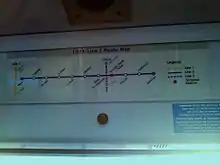

The line runs heavy rail vehicles made in South Korea by Hyundai Rotem powered by Toshiba made VVVF inverters in a four-car configuration. The trains came in together with the fourth package during the system's construction. Trains have a capacity of 1,628 passengers, which is more than the normal capacity of the rolling stock of Lines 1 and 3.
Trains in the line prominently use wrap advertising.
In 2017, the entire train fleet was retrofitted with the TUBE (formerly known as PARDS), a passenger information system powered by LCD screens installed near the ceiling of the train that shows news, advertisements, current train location, arrivals and station layouts.[14]
In 2018, the train ventilation was upgraded to replace the aging air-conditioning units and to alleviate complaints of the commuters for uncomfortable hot rides.[15]
The LRTA is also acquiring 14 additional train sets by 2020 to augment the existing 18 sets, due to the expected increase of passengers ahead of the East Expansion, and the West Expansion.[16]
| Rolling stock | First-generation[17][18][19] |
|---|---|
| Image |  |
| Year | 2003 |
| Manufacturers | Hyundai Rotem and Toshiba |
| Model | 2000 series |
| Number Built (cars) | 72 built (32 cars in service,[20] 4 cars in routine maintenance) |
| Length | 22,500 mm (23,800 mm w/ Couplers) |
| Width | 3,200 mm |
| Height | 4,100 mm (Pantograph lock down) |
| Electrification | 1,500 V DC |
| Body Material | Stainless steel |
| Empty Weight | 152,000 kg (4 car trainset)[17] |
| Configuration | MC-TC-TC-MC |
| Capacity | 1628 passengers (232 seated, 1396 standing @ 7 passengers per m2)[18] |
| Doors | 1400 mm wide; Interior sliding type; 5-doors/side |
| Drive Unit | Gear coupling (WN) Drive |
| Traction Power | 1,500 V single arm pantograph |
| Traction Controller | IGBT-VVVF Type |
| Traction Motor | 120 kW AC induction motor |
| Top Speed | 80 km/h (50 mph) |
| Ventilation | Air conditioned; roof-mounted duct type |
| Status | In service |
Depot
The line maintains an at-grade depot in Barangay Santolan in Pasig City, near Santolan station in the side of Barangay Calumpang in Marikina City. It serves as the headquarters for light and heavy maintenance of the line. It is connected to the mainline network by a spur line.
The depot is capable of storing multiple electric multiple units, with the option to expand to include more vehicles as demand arises. They are parked on several sets of tracks, which converge onto the spur route and later on to the main network.
Extension Projects
East Extension
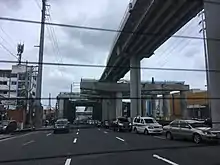

The line's East Extension is currently under-construction which adds 4 kilometers (2.5 mi) of new line, starting from the eastern terminus of Santolan Station up to Masinag in Antipolo. The extension calls for two additional stations, one is in Barangay San Roque, Marikina near Sta. Lucia East Grandmall; and another in Masinag, in Barangay Mayamot, Antipolo near SM City Masinag. The National Economic and Development Authority approved the ₱2.27 billion extension in September 2012.[21] Groundbreaking was held on June 9, 2015 and as of April 2017, the viaduct is now complete, which is package one of the three packages which are part of the east extension project. Meanwhile, Package 2 is the design and construction of the two additional stations, which Package 3 is the design and build of electro-mechanical system of the railway, which is from October 2017 until April 2019. The groundbreaking for the construction of the two stations was held last May 30, 2017. The construction of the two stations is set to be completed by August 2018. In April 2017, Secretary Arthur Tugade of the Department of Transportation or DOTr, announced in the Dutertenomics Forum that the targeted time for the completion of the east extension project is set to be at 4th Quarter of 2020. The project aims to accommodate an additional 80,000 passengers and reduce traffic congestion along Marcos Highway. When the project is completed, it will reduce travel time from Recto to Masinag from 3 hours to only 40 minutes. The East Extension was not completed in the 4th Quarter of 2020, as the Covid-19 Pandemic had caused delays in construction. As such, the extension is instead set to open April 26, 2021.[22]
West Extension
A 3.02-kilometer (1.88 mi) west extension of the line to the Manila North Harbor in Tondo, Manila was proposed. It was approved by the National Economic and Development Authority (NEDA) last May 19, 2015 but has expired and is awaiting revisions and a new approval. The construction of this said extension would create three stations, one near the Tutuban PNR station, one in Divisoria, and one near the North Port Passenger Terminal in Manila North Harbor's Pier 4 which would serve as its terminus.[23] In an interview held with LRTA Administrator Ret. Gen. Reynaldo Berroya, he stated that they are aiming to finish the project by 2022 to 2023.
According to the Line 2 West Extension Project Management Office, the civil works, trackworks, electromechanical system (EMS), and rolling stock of the Line 2 West Extension is projected to begin by the second quarter of 2020 and end by the second quarter of 2023. The total project cost is estimated to be ₱10.1 Billion, inclusive of consultancy services, which will take place from 2019 to 2024. As of April 25, 2019, the procurement of consultancy services is ongoing.[24]
In October 2019, the project is now under bidding process, consisting 3 stations, the Tutuban Station, the Divisoria station, and the Pier 4 station, with a planned completion of the project eyed on 2023.[25]
Incidents
- On May 18, 2019, trainset no. 18 broke down in between the Cubao and Anonas stations at 2:00 PM and was subsequently moved to the emergency pocket track at Cubao station waiting to be towed back to the depot. However at 9:15 PM, the train was reported to have moved on its own from the emergency pocket track towards the eastbound rail track going towards Santolan station. At this time, trainset no. 13 was going towards Santolan station from Cubao station on the same track. The runaway train was reported via radio but eventually ran into train No. 13, injuring 34 passengers, with none in critical condition. The driver of one of the two trains was reported to have jumped out of his train before the collision, sustaining wounds and bruises. Revenue operations were suspended to give way to maintenance checks, and normal operations resumed at 10:47 AM the next day.[26][27]
- On October 3, 2019, a power trip caused rectifier substations located between Anonas and Katipunan stations and in the Santolan depot to catch fire at around 11 in the morning, cutting the line's power supply in the area. Line operations from Recto to Santolan were suspended at 11:24 am, and passengers were evacuated from the line with no injuries. The LRTA, MMDA and the Philippine Coast Guard immediately deployed shuttle buses to help ferry stranded passengers. Partial operations between Cubao and Recto stations resumed on October 8, 2019 while Santolan, Katipunan and Anonas Stations are expected to reopen after nine months. The initial estimated amount of damages is at around PHP428 million.[3] Due to the incident, the Light Rail Transit Authority claimed full operations would be back in 2 to 3 months.[28] As the initial deadline was not met the three stations that were caught in a power trip were expected to resume services at the end of June 2020.[29] However, this deadline was also not met, and as such services were instead expected to resume by January 2021.[30] Another push back occurred, and the three damaged stations are set to reopen in the first quarter of 2021.[22]
References
- "The Line 2 System". Light Rail Transit Authority. Archived from the original on October 11, 2014. Retrieved June 10, 2014.
- "Monthly Ridership – Line 2 System Ridership" (PDF). Light Rail Authority. Retrieved January 4, 2019.
- "Line 2 temporarily halts operation due to power supply problem caused by fire". GMA News Online. October 3, 2019. Retrieved October 5, 2019.
- Guzman, Jimmyley E. (January 22, 2021). "LRT-2 reopens three stations". Philippine Information Agency. Retrieved January 22, 2021.
- Ronda, Rainier Allan (March 31, 2010). "LRT, MRT closed for Holy Week". The Philippine Star. PhilStar Daily, Inc. Retrieved August 21, 2014.
- World Bank (December 2, 2004). "A Tale of Three Cities: Urban Rail Concessions in Bangkok, Kuala Lumpur and Manila – Final Report" (PDF). Author: 17. Cite journal requires
|journal=(help) (Prepared by Halcrow Group Limited). - Climate-Eval (GEF IEO) (August 2009). "Republic of the Philippines: Metropolitan Manila Strategic Mass Rail Transit Development-Line 2" (PDF). Author. Archived from the original (PDF) on August 21, 2014. Retrieved August 18, 2014. Cite journal requires
|journal=(help) (Prepared by Sanshu Engineering Consultant) - Light Rail Transit Authority (October 29, 2013). "Interim Performance Scorecard for CY 2013" (PDF). Author. Archived from the original (PDF) on August 21, 2014. Retrieved August 18, 2014. Cite journal requires
|journal=(help) - LRTA issues directive imposing ban on tin cans Archived August 19, 2006, at the Wayback Machine, Manila Times, August 10, 2005
- New task force formed to keep LRT, MRT safe Archived August 28, 2005, at the Wayback Machine, The Daily Tribune, November 13, 2004
- Casanova, Sheryll B. (November 12, 2003). "MRTC borrows value tickets from LRTA". Manila Times. Archived from the original on January 5, 2004.
- "LRT-MRT FARES TO BE INCREASED ON JAN.4". Department of Transportation and Communications. Archived from the original on December 25, 2014. Retrieved March 10, 2015.
- Diokno, Benjamin E. (December 17, 2013). "Folly of government subsidy". BusinessWorld. BusinessWorld Publishing Corporation. Retrieved April 25, 2014.
- "Line 2 unveils PARDS for passengers". ABS-CBN. ANC. May 6, 2017. Retrieved May 23, 2020.
- Layug, Margaret Claire (May 17, 2018). "Replacing Line 2 aircon units may take up to 12 months—LRTA". GMA News Online. Retrieved May 17, 2018.
- Pateña, Aerol John (March 7, 2019). "Expect more comfortable LRT-2 trains by April: LRTA". Philippine News Agency.
- "Railway Systems-Project Record View". www.hyundai-rotem.co.kr. Retrieved July 17, 2016.
- http://open_jicareport.jica.go.jp/pdf/1000023377_01.pdf
- "LRT2-OM-ProjectInfoMemo-FINAL.pdf" (PDF). PPP Center. Retrieved May 28, 2020.
- LRTA [@OfficialLRTA] (February 22, 2018). "8 trains/32 coaches running with 7 minutes headway this morning. Moderate to heavy volume of passengers at Santolan and Katipunan. Moderate at Anonas and Cubao (Westbound). Light to moderate in all other stations" (Tweet) – via Twitter.
- Gonzalez, Mia M. (September 4, 2012). "Neda Board OKs 9 big projects". Business Mirror. Archived from the original on September 6, 2012. Retrieved September 6, 2012.
- Ong, Ghio. "3 LRT-2 stations set to reopen". Philstar.com. Retrieved January 12, 2021.
- Naguit, Roices (May 19, 2015). "President Aquino approves Line 2 extension to Manila port area, 6 other infra projects". Interaksyon. Archived from the original on May 22, 2015. Retrieved May 20, 2015.
- "Feasiblity Study for Line 2 West Extension Project". Freedom of Information Philippines. Retrieved May 9, 2019.
- "LOOK: Gov't to build 3 more Line 2 stations". ABS-CBN News. October 13, 2019. Retrieved October 14, 2019.
- Barcelon, Paolo (May 19, 2019). "Authorities to probe Line 2 collision that injured 34". CNN Philippines. Retrieved May 19, 2019.
- Rita, Joviland (May 19, 2019). "Probe underway into Line 2 trains collision; 34 hurt". GMA News Online. Retrieved May 19, 2019.
- "Line 2 full operations eyed to resume in 2 to 3 months". ABS-CBN News. October 14, 2019. Retrieved February 4, 2020.
- Luna, Franco (February 3, 2020). "Anonas, Katipunan and Santolan Line 2 stations to be repaired by end of June 2020". Philstar. Archived from the original on June 6, 2020. Retrieved February 4, 2020.
- "LRT-2 aims to resume full operations by January 2021". cnn. Retrieved December 20, 2020.